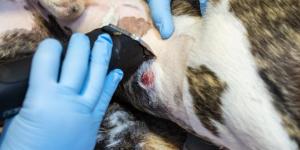My Dog Has an Anal Gland Infection



See files for Dogs
The anal glands of a dog are something we ignore at the animal's peril. Sacculitis, also known as anal sac disease, is something which often gets ignored in its initial stages. Part of the problem is that it can be difficult to tell the difference between normal and abnormal discharge from the glands.
If you think your dog has an anal gland infection, AnimalWised helps you to recognize the signs and symptoms of this canine medical problem. We also look at treatment options, prevention and complications which may be related to this condition.
What are anal glands in dogs?
When we see a dog smell another dog's rear, it is not simply a quirk of canine behavior. They press their nose against the perianal area to help the dog's anal glands to release a scent. Each dog has their own unique smell which helps other dogs to identify them.
It is not only when greeting each other that dog's leave a scent. Dogs will often scoot on the ground to leave their odor in an area as a form of scent marking. This is because the dog is a territorial animal and they want to alert other animals they consider a given area belongs to them.
The anal glands of dogs are located between the internal and external anal sphincter muscles. They can be seen at the ‘nine’ and ‘three’ o'clock positions if the anus is in the center. The glands secrete fluid into the sacs which is released via a duct. The outer gland is surrounded by fibrous connective tissue.
When a dog defecates, discharge from the anal glands is released. This means the dog can mark its territory in other ways than urinating. Another occurrence of discharge happens when the dog is frightened. While we are not exactly sure why this is the case, it is likely an involuntary action caused by the contraction of sphincter muscles. It would not likely cause much of a deterrent to a predator.
The glands are also known as anal sacs as they retain fluid. This fluid is released specifically by sebaceous glands, glands found in hair follicles on other parts of the body. The color of the fluid which is released varies from different shades of yellow and brown. It can be of varying consistency, from thin fluid to a thick paste-like secretion. Since the consistency and color is variable even in healthy dogs, it can be difficult to recognize an anal gland infection[1].
Normal discharge of the anal glands should happen regularly. For various reasons, some dogs will have an accumulation of fluid in the anal sacs. This does not mean it is in itself a problem. There are some instances when glands will need to be expressed by their caretaker if they are unable to do it themselves. Fluid accumulation does not necessarily mean the anal glands are infected, but we need to be careful to make the distinction.
Impacted anal glands in dogs
Although the anal glands are used regularly, they can become impacted. This is when the ducts of the anal sac become blocked. Since the glands are so close to the anus, fecal matter can clog the ducts and cause fluid to build up. Although the duct is blocked, the gland will still release fluid and become swollen. It is not usually visible until a sufficient amount has been collected.
Another reason a dog's anal glands may become impacted is when they have diarrhea, usually over a prolonged period. During healthy defecation, the dog will express their glands. When the stool is loose, it does not require the dog to engage their sphincter muscles as much. This means the anal glands aren't as readily expressed. If the dog has not defecated for some time, for whatever reason, the anal gland may be impacted.
Age and obesity may be a factor in anal gland impaction in dogs. With older dogs, their sphincter muscles may weaken with age and make it difficult to express the glands. This results in the impacted anal glands of dogs swelling, i.e. sacculitis. Obese dogs are often more prone to impaction thanks to poor gastrointestinal health.

How to know if a dog's anal glands are infected
Since a dog will discharge their anal sacs regularly, it is important that we tell the difference between normal gland expression and an anal gland infection. Although anal gland impaction and infection are not the same, the latter often derives from the former. When the duct is impacted, it is essentially plugged and stops the flow of fluid. However, the gland will still produce fluid which results in a build-up.
The pressure on the sphincter muscles caused by impaction means it can make defecation difficult for the dog. Also, since feces contains a lot of bacteria, this can cause the glands to become infected. When an infection happens, it is likely an abscess will develop.
Anal sac disease (sacculitis)
When a dog's anal glands become infected, they will become swollen. It is this swelling which is known as sacculitis or anal sac disease. It can be difficult to tell when a dog has anal sac disease. In its early stages, you may see the dog scooting on the ground. This could be to relieve the irritation caused by the infection, but it is also possible the scooting will help to release an impacted gland.
Other than scooting, other signs of infected anal glands in dogs include:
- Pain when defecating
- Abnormally shaped stool
- Constipation
- Swelling of the glands
- Redness
- Dog intensely licking private area
- Fishy smell from rear
- Abscess
When an abscess develops, the infection is usually very painful and problematic for the dog. They are unable to defecate properly and if the infection spreads it can threaten the dog's overall well-being.
Find out the reasons other than impacted anal glands in dogs why a dog's anus smells fishy.
Expressing a dog's anal glands
If the dog has impacted anal glands, they may try to express them themselves. This could be done by scooting or pressing their rear against another surface. However, many dogs will need help expressing their glands. This may be a rare occurrence, but many dogs have chronic anal sac problems and may need regular expressing.
While it is best to take the dog to a veterinarian for the procedure, many dog guardians will choose to do it themselves. Gloves should be used for our own hygiene and to protect the dog form bacterial infection. A dog's anal glands can be expressed using the following method:
- Take a piece of clean gauze and hold it over your forefinger and middle finger.
- Place some lubricant on the gauze and hold it just over the anus. The gauze will help to prevent the fluid from squirting out.
- The glands are at the ‘nine’ and ‘three’ o'clock positions. Insert your fingers inside the anus and find the first gland. Press down firmly on it until the fluid is drained onto the gauze.
- In smaller dogs it might be possible to express both glands at once, but larger dogs may need pressure on both sides.
- Once the fluid is drained, clean the area with a suitable disinfectant.
It may be best to have another person present. They can hold the dog to stop them from running away or sitting down when we express the glands.
Treating anal gland infection
When the anal gland becomes infected and anal sac disease occurs, the infection will need to be treated. This may include first expressing the glands. However, the pain makes this difficult and the dog may need an analgesic to reduce the effects of the pain.
Since abscesses occur when there is a severe infection, the dog may need antibiotic treatment. A combination of pain relief and antibiotics may be used to treat the infection before the glands are expressed.
In very severe cases, the anal glands may need to be removed. This is also a possibility for dogs which have chronic or recurring anal gland problems. Surgical removal is a relatively safe procedure, but not all veterinary practices will offer it, so a referral to a veterinary surgery may need to be made.
Due to the need for antibiotics and the possibility of surgical removal, we need to take a dog with infected anal glands to the veterinarian. They will be able to run analytics to determine the kind of bacterial infection and to prescribe the corresponding antibiotic treatment.

Other anal gland problems
While impaction and infection of the anal glands are the most likely problem for a dog, it is possible there are other issues which might be related. They include:
- Tumor: there are two types of anal sac disease, neoplastic and non-neoplastic[2]. Non-neoplastic diseases are the infections described above. Neoplastic diseases are those which also have abnormal growth of tissue, often in the form of a type of canine tumor. A cancerous carcinoma of the anal gland's apocrine gland can occur, although it is relatively rare.
- Perianal fistula: a fistula is when an abscess diverts part of its fluid through a tunnel to another place in the tissue. A fistula can occur in another part of the area around the anus (perianal area).
- Rectal prolapse: while not necessarily caused by inflammation, a rectal prolapse in dogs might look similar to an anal gland abscess.
- Skin disease: a wide variety of skin diseases may be affecting the perianal area, due to allergies, parasites, infections or other causes.
Proper diagnosis from a veterinarian is required to confirm either cancerous tumor or a fistula. The treatment will be dependent on the underlying cause.

This article is purely informative. AnimalWised does not have the authority to prescribe any veterinary treatment or create a diagnosis. We invite you to take your pet to the veterinarian if they are suffering from any condition or pain.
If you want to read similar articles to My Dog Has an Anal Gland Infection, we recommend you visit our Other health problems category.
1. van Duijkeren, E. (1995). Disease Conditions of Canine Anal Sacs. Journal of Small Animal Practice, 36(1), 12-6.
https://pubmed.ncbi.nlm.nih.gov/7815780/
2. Jung, Y., et al. (2016). Diagnostic imaging features of normal anal sacs in dogs and cats. Journal of Veterinary Science, 17(3), 331-335.
https://www.ncbi.nlm.nih.gov/pmc/articles/PMC5037300/








